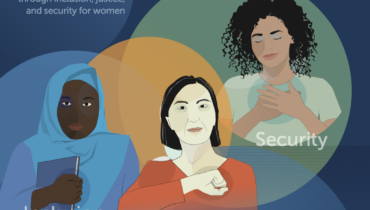Since its launch in 2017, our Women, Peace and Security Index has been around the world, from London to Addis Ababa, Oslo to Canberra. Recently, the Index made an unlikely appearance — in court.
The WPS Index provides the most comprehensive ranking to date of women’s well-being around the globe. This past year, our evidence-based research became actual evidence. In a court case in Maryland last fall, lawyers from Montgomery County’s Department of Health and Human Services submitted our WPS Index to support their case — and won.
Fans of Law & Order will recall what an expert witness is, and how their testimony can sometimes make or break a case. In fact, an expert witness is not always required to prove a point. A legal provision known as judicial notice allows the court to take account of other sources of expertise — including social science research like our Index — so long as they meet an important criterion: that they are not subject to reasonable dispute.
Judicial notice became standard practice after the 1907 Muller v. Oregon case, in which Louis Brandeis argued before the Supreme Court the constitutionality of limiting hours for female laundry workers. Submitting social science data to underscore his argument, the case has since become known for the “Brandeis brief” — the citation of non-legal data in a legal brief. Since Brandeis, judicial notice has been employed in a number of landmark cases, including Brown v. Board of Education, where social science research was used to prove that separate is, in fact, not equal.
In effect, judicial notice simplifies and streamlines the process of introducing evidence in court by allowing parties to submit social science research as judicially noticeable facts, which reduces the costs of hiring expert witnesses.
According to Alvin McIntyre Ehrlich, one of the DHHS lawyers in the recent Maryland case, “The cost savings was the first reason that drew us to this strategy. And also the elegance of just offering a document with data that is, on its face, beyond dispute. Why engage an expert, pay thousands of dollars for that person to say what the document already says?”
This speaks to another reason why judicial notice is such an appealing legal tool: It’s powerful. Since the standard for judicial notice is high, judicially noticed facts can be a critical factor in deciding a case. Once judicially noticed, the jury must accept that fact as conclusive, and your opponent cannot present evidence to contradict it.
According to Mr. Ehrlich, “Our judge ruled that the WPS Index was judicially noticeable impliedly because the facts and data in the study were beyond dispute, among other reasons, because they were gleaned by such a reputable academic institution.”
According to Jeni Klugman, Managing Director of GIWPS, choosing reputable and publicly available data was critical in formulating the WPS Index. “Having worked on other influential multidimensional indices, in particular the UNDP’s Human Development Index, I knew that widespread acceptance depends upon the credibility of the underlying data,” said Klugman. “So when we were developing the WPS Index, the criteria of transparency and reliability were uppermost in our minds, alongside having a measure that was as simple and transparent as possible.”
In a world where our digital culture deeply impacts the quality of information that is easily accessible, such evidence-based and reliable resources are at a premium. In this context, GIWPS carries an important responsibility to hold ourselves to a rigorous standard in our research. This is not just important from a big-picture policy standpoint, but because these issues can have very real impacts in people’s lives — even, apparently, in a Maryland courthouse.
At GIWPS, we’re building the evidence-based case for women’s meaningful participation in peace and security efforts. We do this in many ways — by holding global convenings, honoring trailblazing leaders, and bringing stories of women on the frontlines in our podcast. Our WPS Index is another powerful tool to convince policymakers and practitioners that women’s inclusion, security, and access to justice are critical.
“Your report spoke to almost every stage of a girl’s life,” said Mr. Ehrlich, who emphasized that the comprehensive nature of our data proved useful in deciding their case. “It enriched the trial for me.”
The Index fills an important gap by bridging insights from gender and development indices with those from peace and security indices. By evaluating countries based on three critical dimensions — inclusion, justice and security — it reflects women’s autonomy and empowerment as agents at home, in the community, and in society. Developed in collaboration with the Peace Research Institute of Oslo, it expresses a shared vision that, on the whole, countries are more peaceful and prosperous when women are full and equal members of society. But more importantly, it brings the evidence to bear to support this vision.
“The aspects that we have chosen — like safety in the home as well as in the community — also resonate deeply, and have relevance around the world, from Maryland to the poorest countries of the world,” said Jeni Klugman. “It seems that these features have helped to promote the popularity and broad acceptance of the WPS Index, within a relatively short period of time. We are hoping that awareness and pick-up will be promoted further with the second edition of the index, later this year.”


